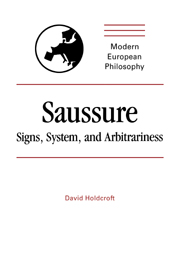Book contents
- Frontmatter
- Contents
- Preface
- Introduction
- 1 Saussure's work: its context and significance
- 2 The distinction between langue and parole
- 3 Language as a system of signs, I: Signs, arbitrariness, linearity, and change
- 4 Language as a system of signs, II: Diachronic and synchronic linguistics
- 5 Language as a system of signs, III: Identities, system, and relations
- 6 Language as a system of signs, IV: Values, differences, and reality
- 7 Successes and failures
- Notes
- Bibliography
- Index
4 - Language as a system of signs, II: Diachronic and synchronic linguistics
Published online by Cambridge University Press: 11 January 2010
- Frontmatter
- Contents
- Preface
- Introduction
- 1 Saussure's work: its context and significance
- 2 The distinction between langue and parole
- 3 Language as a system of signs, I: Signs, arbitrariness, linearity, and change
- 4 Language as a system of signs, II: Diachronic and synchronic linguistics
- 5 Language as a system of signs, III: Identities, system, and relations
- 6 Language as a system of signs, IV: Values, differences, and reality
- 7 Successes and failures
- Notes
- Bibliography
- Index
Summary
Discussion of the factors which explain the mutability and immutability of language led to awareness of the importance of time. But few people have suspected, Saussure argues, that an adequate treatment of the effect of time calls for a radical distinction between two branches of linguistics, synchronic and diachronic linguistics.
At first sight, this second great dichotomy of CLG is much easier to grasp than the first, that between langue and parole, in that it seems to involve no more than a distinction, created by one's point of view, between studying a thing as it changes through time and studying it at a moment in time (Amacker 1975, 56). But though the first of the explanations Saussure himself gives of the distinction perhaps suggests a view like this, in the course of subsequent discussion he elaborates a distinction which is much more complicated and which involves criteria that are not just temporal.
It also becomes clear in the course of this elaboration why the relatively straightforward account given above of the distinction will not do from Saussure's point of view. For it implies that the subject matter of the two branches of linguistics is the same thing studied from different perspectives, whereas it is a cardinal point of Saussure's developed theory that this is not so. Synchronic linguistics studies langue, which is a system that is psychologically real, whereas diachronic linguistics is concerned with relations of succession between individual items, which speakers are unaware of and which are in no sense systematic.
- Type
- Chapter
- Information
- SaussureSigns, System and Arbitrariness, pp. 69 - 87Publisher: Cambridge University PressPrint publication year: 1991

